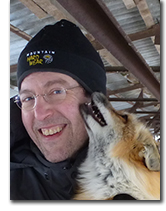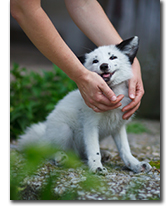How to Tame a Fox (and Build a Dog): Hefner Museum presents its annual lecture Nov 15


Dr. Dugatkin with foxy friend
Thousands of years ago, our ancestors began the process of domesticating animals — transforming large, wild, and aggressive species into the tame and useful breeds we have today. Although domestication of both plants and animals continues, the processes by which some of our favorite cute, cuddly, loyal breeds have come forth remain shrouded in questions and historical mystery.
For its annual popular lecture, the Hefner Museum of Natural History showcases this mystery with "How to Tame a Fox (and Build a Dog): Visionary Scientists and a Siberian Tale of Jump-Started Evolution." Lee Dugatkin, professor of biology and university scholar at The University of Louisville, will share his adventures documenting these fascinating experiments.
Dugatkin's research, conducted along with Russian geneticist Lyudmila Trut, was recently featured in American Scientist magazine ("How to Tame a Fox and Build a Dog").
The event takes place on November 15 at 7 pm in Benton Hall Auditorium (room 102), on Miami's Oxford campus. The lecture is a free, family-friendly presentation and open to the public of all ages. It will be followed by a reception (with food) and book signing.
More than 7 decades ago, an effort to answer some questions on where popular breeds come from began in Russia with an attempt to recreate the domestication process of wild canines. The selective breeding of red foxes, a notoriously bad-tempered species, produced results that were both rapid and surprising.

A highly domesticated fox
"From a population of snarling and fearful animals arose calm and trusting individuals, some of which show traits like spotted coats, floppy ears, and curly tails," said Hefner Museum director Steve Sullivan. "All of the new foxes were very cute, and some even seemed to attempt human laughter as a way to solicit attention from their keepers."
The results of this traditional selective breeding program, coupled with analysis through modern molecular techniques has given us important insights into the process and mechanisms of domestication. Put another way, we are learning why dogs are so cute and cuddly and bond well to humans.
Dugatkin, who co-wrote How to Tame a Fox (and Build a Dog) with Trut, has won the American Association for the Advancement of Science "Excellence in Science Books" award.
"Dr. Dugatkin's presentation is sure to be of interest to people of all ages, including those who love science, history, a good story, and puppies!" said Sullivan.
The Hefner Museum of Natural History is open to students and the public weekdays 9 am-4 pm, located at 100 Upham Hall on Miami's Oxford, Ohio campus.
"Students from all majors should find something of interest in our museum this year," Sullivan said. "Topics range from molecular biology and morphology to political science and Russian history."
The Hefner Museum also loans inquiry learning kits to educators of all types. Learn more information about the Museum, the lecture, any of its programs, or to sponsor a program:
- Hefner Museum of Natural History
(513) 529-4617

